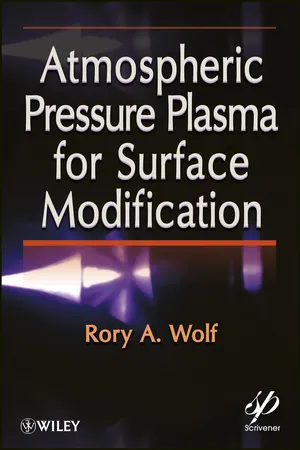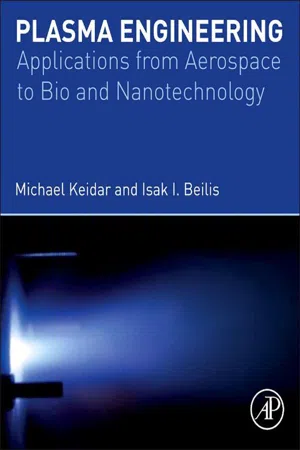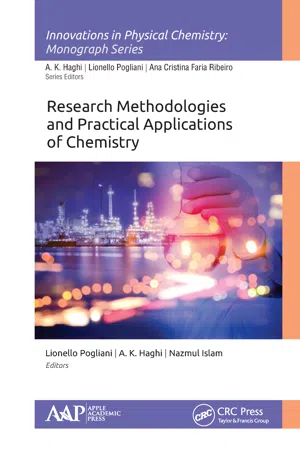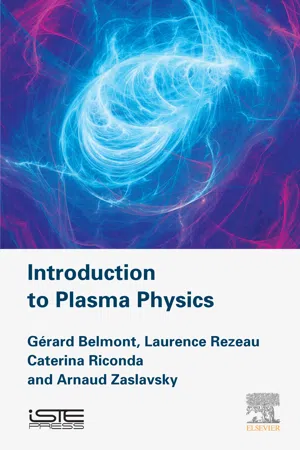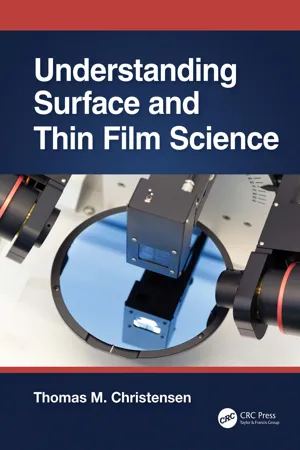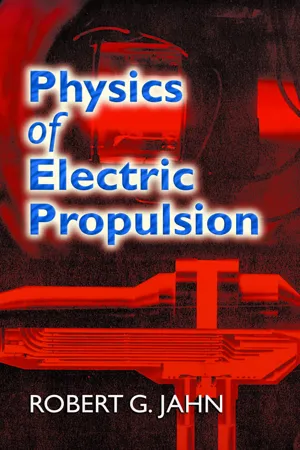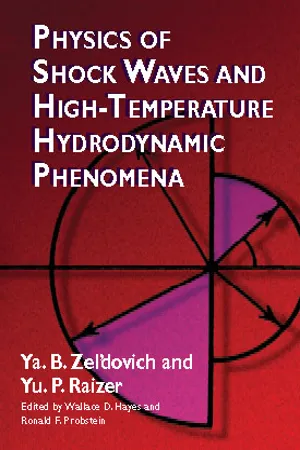Physics
Ionized Gas
Ionized gas refers to a state of matter in which gas particles have lost or gained electrons, resulting in the formation of positively or negatively charged ions. This process occurs at high temperatures or through exposure to strong electromagnetic fields. Ionized gases are important in various fields, including astrophysics, plasma physics, and industrial applications such as plasma cutting and welding.
Written by Perlego with AI-assistance
Related key terms
Related key terms
1 of 4
Related key terms
1 of 3
9 Key excerpts on "Ionized Gas"
- Rory A. Wolf(Author)
- 2012(Publication Date)
- Wiley-Scrivener(Publisher)
2 O) is in a crystalline (ice) and solid form as an exemplified first state of matter, a strongly-coupled medium (the binding energy is large compared to thermal energy) when it is below 273 K (0.0 Celsius). When the temperature of water is between 273 K and 373 K, the coupled crystalline bonds become disassociated. However, large molecular-size structures still exist and create the second state of matter for water, a liquid which is also a medium with strongly coupled bonds. When temperatures are raised to levels above 373 K (100 Celsius), the structural molecular bonds are disassociated and the water molecules form a gas which is known to be steam, its third state of matter. If this stream is heated further to a temperature where the binding energy of the water molecules reaches approximately 0.3 electron volts, its molecules further dissociate into separate hydrogen and oxygen atoms. Although this state of matter for water is no longer steam, it is still a gas whereby the hydrogen and oxygen species are electrically neutral. This third state of matter then becomes a neutral gas which is no longer strongly coupled as a medium. The fourth state of matter is finally achieved with water when the gas is heated to the point where a large proportion of the water’s atomic bonds are completely dissociated into negatively charged electrons and positively charged ions. An Ionized Gas is therefore formed. The proportion of atoms that become dissociated describes the degree of gas ionization. As temperature is increased, collisions between atoms increase and create greater (if not complete) ionization within the medium. This Ionized Gas medium achieves a plasma state where a multitude of charged particles interact within an electromagnetic field. If this plasma gas medium were to be heated further, the collective particles within the plasma would break apart nuclear and quark bonds to form another form of plasma beyond the scope of this work.To explain in further depth what is defined as an Ionized Gas, there are significant numbers of unbound (free) electrons and electrically charged ions with neutral atoms and molecules which are normally resident in a gas. It is important to note that although these electrons are unbound, they are not “free.” Rather, when the charges move they generate electrical currents with magnetic fields. As a result, they are affected by each other’s magnetic fields. This ultimately governs their collective behavior. When the gas is neutral, two-particle (binary) collisions are the predominant particle interactions. Plasmas resulting from ionization of neutral gases generally contain equal numbers of positive and negative charge carriers. But again, when a plasma is formed by ionizing the gas, the charged particles will interact with other charged particles in the plasma in a collective manner. The behaviors of plasmas are therefore determined by the inherently weak interactions between the charged particles within it. The charged particles within plasmas interact collectively within the confines of the plasma’s electromagnetic fields. Coulomb’s law states that “the magnitude of the electrostatic force of interaction between two point charges is directly proportional to the scalar multiplication of the magnitudes of charges and inversely proportional to the square of the distances between them.” Many charged particles interact simultaneously in these collective interactions because the Coulomb electrostatic force induced by each charged particle is a force that decreases as the reciprocal of the square of the distance from the charged particle. Therefore, a charged particle will encounter the electrostatic forces from nearby charged particles. This interaction is collective because the nearby particles also react to the electrostatic forces from all the other nearby charged particles. Hence, a plasma can be described as a highly active ionizing and polarizing medium.- eBook - ePub
Fundamentals of Ionized Gases
Basic Topics in Plasma Physics
- Boris M. Smirnov(Author)
- 2012(Publication Date)
- Wiley-VCH(Publisher)
Chapter 1 General Concepts in Physics of Excited and Ionized Gases 1.1 Ideal Plasma 1.1.1 Plasma as a State of MatterThe word “plasma” was introduced into science by the Czech physiologist J.E. Purkinje in the middle of the nineteenth century to denote the uniform blood fluid that is released from particles and corpuscles. This term was suggested for a uniform Ionized Gas of the positive column of a gas discharge by Langmuir [1–3] and now this term denotes any system with electrons and ions where charged particles determine the properties of this system. The most widespread form of plasma is an Ionized Gas which consists of atoms or molecules with an admixture of charged particles, electrons and ions. Such a plasma is the subject of this book.To understand the conditions required for the existence of such a plasma under equilibrium conditions, we compare it with an identical chemical system. Let us consider, for example, atmospheric air consisting basically of nitrogen and oxygen molecules. At high temperatures, along with the nitrogen and oxygen, nitrogen oxides can be formed. The following chemical equilibrium is maintained in air:(1.1)Here and below, the sign ↔ means that the process can proceed either in the forward direction or in the reverse direction. According to the Le Chatelier principle [4, 5], an increase in the temperature of the air leads to an increase in the concentration of the NO molecules.A similar situation exists in the case of formation of charged particles in a gas, but this process requires a higher temperature. For example, the ionization equilibrium for nitrogen molecules has the form(1.2)Thus, the chemical and ionization equilibria are analogous, but ionization of atoms or molecules proceeds at higher temperatures than chemical transformations. To illustrate this, Table 1.1 - eBook - ePub
Plasma Engineering
Applications from Aerospace to Bio and Nanotechnology
- Michael Keidar, Isak Beilis(Authors)
- 2013(Publication Date)
- Academic Press(Publisher)
Chapter 1 Plasma Concepts1.1 Introduction
When a neutral gas is ionized, it behaves as a conductive media. Ionization process is the phenomenon associated with striping electrons from the atoms thus creating the pair of negatively and positively charged particles. Electrical properties of such Ionized Gas depend on the charged particle density. One of the most important distinctions between the Ionized Gas and the neutral media is that Coulomb interaction between charged particles determines the dynamic of the gas. Ionized Gas is able to conduct the current. This property is of particular interest in the presence of the magnetic field when the interaction of the current and magnetic field leads to electromagnetic body force thus altering its flow dynamics. There are weakly Ionized Gases and strongly Ionized Gases. Weekly Ionized Gas is characterized by a relatively small fraction of charged particles and its behavior can be largely described by neutral gas laws while one needs to invoke electrodynamics to describe appropriately the strongly ionized media. We shall call a physical state of an Ionized Gas in which the densities of positively and negatively charged particles are approximately equal as a quasi-neutrality state. Plasma is defined as an Ionized Gas, which satisfies the quasi-neutrality condition.Development of the plasma physics was always associated with particular applications. Starting from lighting sources, current interrupters, thermonuclear fusion, and plasma accelerators, nowadays plasma applications range from plasma processing, space propulsion, nanotechnology, and plasma medicine.Prominent physicists contributed to developing the field of the plasma physics and engineering. Irving Langmuir (1881–1957) initiated an active study of the plasma as a new direction of science. The term “plasma” was introduced in 1928 in his article describing the positive column of low-pressure gas discharge. While Langmuir introduced the term plasma, the matter in the plasma state was known to human since much early times. Lighting, northern light, solar wind, and Earth ionosphere are some examples of plasmas. Irving Langmuir received the Nobel Prize in Chemistry, 1932. Mott-Smith indicated in his letter [1] - Lionello Pogliani, A. K. Haghi, Nazmul Islam, Lionello Pogliani, A. K. Haghi, Nazmul Islam(Authors)
- 2019(Publication Date)
- Apple Academic Press(Publisher)
2The word “plasma” comes from Greek “πλασμα” which means something molded. To describe the behavior of Ionized Gas in an electrical discharge, Nobel laureate Irving Langmuir and Lewi Tonks in 1929 used the term “plasma.”2 , 3 Plasma is the fourth state of matter and the most natural state of matter (~99%) in the universe and is defined as “an Ionized Gas or a quasi-neutral gas in which the presence of unbound (freely moving) charged particles (usually electrons and positive ions) in large number along with neutral particles; each particle interacts simultaneously and collectively with its innumerable, immediate nearby, and distant neighbor charged particles through their electromagnetic fields.”1 , 4The electrons and ions in the plasma are completely free to move and can give rise to current. The electrons due to their light and fast nature are the main contributors, and ions being heavy and slow provide a neutralizing background. Although plasma is electrically neutral, it is electrically conducting; it is an electrically neutral conductor capable of interaction with electric and magnetic fields. The force of interaction between plasma and neutral gas is entirely different, and this is the basic difference between them. In a neutral gas, the type of interaction between particles is of Van der Waal’s type, short range as well as strong, that is, the interactions are dominated by isolated, distinct two particle collisions (binary collisions), whereas in a plasma, this force is of coulomb type, that is, long range and weak at very large distances. The long-range Coulomb force is a factor, which determines the statistical properties of the medium. The typical particle interaction energies are small compared to the thermal energies of the particle. Thus, plasma is a collective but weakly coupled medium in which interaction energies are much smaller than thermal energies. For a charged particle gas to be called as plasma, collective effects are important. These collective rather than binary charged particle interactions lead to a wide variety of interesting phenomena in plasma like collective (Debye) shielding of individual charges, dielectric medium response to perturbations, oscillations at the “plasma” frequency, and wave propagation.1, 3- eBook - ePub
- Gerard Belmont, Laurence Rezeau, Caterina Riconda, Arnaud Zaslavsky(Authors)
- 2019(Publication Date)
- ISTE Press - Elsevier(Publisher)
Under the “normal” temperature and pressure conditions in which we live, particles are naturally bound in the form of neutral atoms and molecules (although, in the rest of the universe, this “fourth” state of matter is the normal state). To create plasma from such a neutral gas, it is necessary to provide energy to remove one or more electrons from each atom. It is therefore necessary that sufficient energy be provided to the atoms so that they are partially, or even totally, ionized. This energy can be provided in many ways.1.1.1 Electric discharges
As I. Langmuir first showed, a gas can be ionized and a plasma created when we produce an electric discharge in it. Such plasmas are indeed present in our familiar surroundings, for instance, in certain types of lamps, neon signs and lightning (see Figure 1.1 ). Others are also created in the same way for research purposes, as will be seen in the following (see Figure 1.2 ).Figure 1.1 Lightning. For a color version of this figure, see www.iste.co.uk/belmont/plasma.zip (source: Y. Faust)Figure 1.2 Discharge in a helium jet at atmospheric pressure. The discharge propagates to the surface of a glass cell in which a second discharge in helium at low pressure is initiated. For a color version of this figure, see www.iste.co.uk/belmont/plasma.zip (source: O. Guaitella)1.1.2 Heating
In nature, ionization is often produced by thermal collisions between atoms (or molecules) if their temperature is high enough. For a set of atoms maintained in local thermodynamic equilibrium by collisions, when the atoms’ average kinetic energy kBT becomes of the order of the atom’s ionization energy (≈ eV), the fraction of ionized atoms becomes significant. The effect of temperature on the ionization state of a gas was first described by astrophysicist M. Saha in 1920, and is summarized with the equation called “Saha’s ionization equation”, which provides, in the hypothesis of a weakly ionized plasma in a thermodynamic equilibrium state, the atom density in each ionization state as a function of the ionization energies and the temperature. Figure 1.3 - eBook - ePub
- Thomas M. Christensen(Author)
- 2022(Publication Date)
- CRC Press(Publisher)
The third set of electron collision reactions are those that change the chemical species present in the plasma typically through the dissociation of molecules. When an electron strikes a molecule, the molecule may dissociate in several ways. The molecule may break up into its component atoms with each of the atoms (which may be in excited states) being electrically neutral. One of the component atoms from the molecule may be ionized in the dissociation process leading to a change in both the chemistry and the charged particle distribution. It is also possible for the charge in the molecule to redistribute on dissociation so that both a positive and a negative ion are formed upon dissociation.Collisions among the atoms, molecules, and ionized species are also possible. We mentioned earlier the example of Penning ionization where an excited atom collides with a neutral atom resulting in the ionization of the neutral atom. Similarly, the collision of two excited atoms might cause the ionization of one of the atoms. The collision of an ionized atom with a neutral atom can cause charge to be transferred from one atom to the other. Even though the overall charge distribution does not change in this reaction, if the two atoms are different elements, this will change the distribution of charged atoms of these particular elements.Gas-phase chemistry is normally dependent on thermodynamic rate constants that assume that temperature is the driving force causing chemical reactions. As we can see from the discussion in this section, plasma chemistry is considerably more complicated with a large number of non-thermal processes driving the chemistry.2.2.6 Applications of Plasmas
We will encounter plasma environments frequently throughout this book. Some examples are in the cleaning and etching of surfaces, as a source for sputter deposition, in the bombardment of growing thin films during deposition to modify film properties and in the activation of reactive gases (for instance in Chemical Vapor Deposition). In any of these applications, we tend to be making use of one or both of two important properties of plasmas. One of these properties is simply the presence of charged particles that can be controlled by the application of electric and magnetic fields. This will allow us to have some control over which collisions are encouraged or discouraged and the energies of those collisions. The second property is the unique chemical environment found in the plasma that can allow us to drive certain chemical reactions to occur more readily at temperatures below where they would be expected to be significant in thermal processes. - eBook - ePub
- Robert G. Jahn(Author)
- 2012(Publication Date)
- Dover Publications(Publisher)
AIAA J., vol. 2, pp. 1072 and 1080, 1964.Passage contains an image
4
Particle Collisions in an Ionized Gas
Virtually every gas property of engineering interest ultimately derives from the multitude of atomic-scale interactions, or collisions, which are incessantly in progress within the gas. The transport processes, such as mass diffusion, viscous friction, thermal conduction, conduction of electric current, etc., are accomplished by the migration of the atomic particles within the gas, or by transfer of their momenta and energy through the gas, and therefore are controlled primarily by the frequency and effectiveness of their collisions. The rate at which the gas can adjust to changes in its environment, and find a new equilibrium state after it has been disturbed from a previous one, is determined mainly by the efficiency of the collisional communication system among the atomic particles. As we have seen, the equilibrium state itself may be regarded as a balance between collisional events which produce a particular set of species products and other collisional events which reverse the reactions. Even the continuum thermodynamic properties, such as pressure, temperature, and entropy, are macroscopic manifestations of atomic collision processes, and kinetic theories of neutral gases have been carried to considerable elegance to establish the correlation between collisional mechanics and these thermodynamic properties [1,2].4-1 ATOMIC COLLISION NOMENCLATURE
Important as atomic collision information may be for detailed understanding of Ionized Gas behavior, it is extremely difficult to accumulate and catalog. Even in the simplest Ionized Gas, composed only of electrons, single positive ions, and neutral atoms, there are six permutations of particle collision to be considered: electron-ion, electron-atom, electron-electron, etc. In all but the electron-electron collisions, the interaction may yield a variety of results. First, the event may be distinguished by one of several types of energy exchange (Fig. 4-1 - Ya. B. Zel’dovich, Yu. P. Raizer, Yu. P. Raizer(Authors)
- 2012(Publication Date)
- Dover Publications(Publisher)
2. Gases with Coulomb interactions§11. Rarefied Ionized Gases
Let us consider the departure of an Ionized Gas from an ideal one as a result of the Coulomb interactions between charged particles. In this section we shall restrict ourselves to the case of “weakly” imperfect gases, where the terms representing the Coulomb interactions in the thermodynamic functions can be considered as small corrections to the terms describing a perfect gas.In order to consider an Ionized Gas as a perfect one, it is necessary that the energy of the Coulomb interactions between neighboring particles be small in comparison with the thermal energy of the particles, that the condition (Ze )2 /r 0 κT holds. Here, Z is the average charge of the particles (ions and electrons) and r 0 ≈ n —1/3 is the average distance between them (n is the number of particles per cm3 ). This condition can be rewritten as(3.77)For example, if the degree of ionization is of the order of unity (Z ∼ 1) and T∼ 30,000°K, the gas can be considered as a perfect one when n 6.2 · 1021 cm—3 (for comparison, we recall that the number of molecules in air at standard conditions is 2.67 · 1019 cm—3 ).Coulomb corrections to the thermodynamic functions in the case of weakly imperfect gases can be calculated by the Debye-Hückel method as was done in the text by Landau and Lifshitz [1] (see also the paper of Timan [11]). A spherically symmetric nonuniformly charged cloud of particles of like charge is formed about each ion or electron. The distribution of charge density in each cloud is the Boltzmann distribution corresponding to the electrostatic potential of the central charge and the cloud. The solution of Poisson’s equation for the electrostatic potential distribution with respect to the radius r from the central ion of charge Z i e- eBook - ePub
- A. C. Phillips(Author)
- 2013(Publication Date)
- Wiley(Publisher)
2
Properties of matter and radiation
A stellar interior is an environment in which matter and radiation at high temperature produce a pressure to oppose gravitational contraction. The conditions are extreme: the atoms are ionized, the electrons can be degenerate and ultra-relativistic, and the pressure due to radiation can be significant. Nevertheless, despite this complexity, many of the properties of stellar interiors can be understood by considering the simplest thermodynamic system, the ideal gas. However, we shall need to go beyond the familiar ideal gas in which the particles are both classical and non-relativistic, and consider the ideal gas in its most general form. We shall give particular attention to the properties of electron and photon gases and consider their relevance to stellar structure. In addition, we shall consider the thermodynamics of the dissociation of molecules, the ionization of atoms, the photodisintegration of atomic nuclei and the production of particle–antiparticle pairs.2.1 THE IDEAL GAS
The ideal gas is a large number of particles occupying quantum states whose energy is unaffected by the interaction between the particles. The particles we have in mind may be atoms, ions, electrons, photons, neutrinos, etc. The effects of quantum mechanics and special relativity will often be important in the gas; only in particular circumstances will it be an appropriate approximation to treat the particles as classical and non-relativistic.Density of states
The gas particles can act like waves and we can use these wave-like properties to enumerate the possible quantum states that can be occupied by the particles. We assume that the particles are confined in a cubical box of volume V = L 3 . Confinement to such a box implies that the quantum states can be represented by standing waves of the form sinkx xsinky ysinkz zwith wave vector k
Index pages curate the most relevant extracts from our library of academic textbooks. They’ve been created using an in-house natural language model (NLM), each adding context and meaning to key research topics.
Explore more topic indexes
Explore more topic indexes
1 of 6
Explore more topic indexes
1 of 4
